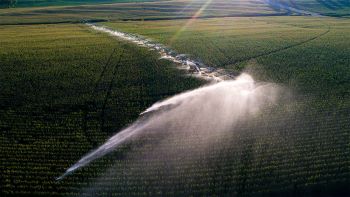New study finds aquifer depletion threatens crop yields
- January 17, 2024
- Posted by: Elaine Coles
- Category: Agriculture, Environmental, Water Issues, North America

Three decades of data have informed a new Nebraska-led study that shows how the depletion of groundwater — the same that many farmers rely on for irrigation — can threaten food production amid drought and drier climes.
The study found that, due in part to the challenges of extracting groundwater, an aquifer’s depletion can curb crop yields even when it appears saturated enough to continue meeting the demands of irrigation. The agricultural losses escalate as an aquifer dwindles, the researchers reported, so that its depletion exerts a greater toll on corn and soybean yields when waning from, say, 100 feet thick to 50 than from 200 feet to 150.
That reality should encourage policymakers, resource managers and growers to reconsider the volume of crop-quenching groundwater they have at their disposal, the team said, especially in the face of fiercer, more frequent drought.
“As you draw down an aquifer to the point that it’s quite thin, very small changes in the aquifer thickness will then have progressively larger and larger impacts on your crop production and resilience,” said Nick Brozović, director of policy at the Daugherty Water for Food Global Institute. “And that’s a thing that we don’t predict well, because we tend to predict based on the past. So if we base what’s going to happen on our past experience, we’re always going to underpredict. We’re always going to be surprised by how bad things get.”
The team came to its conclusions after analyzing yields, weather and groundwater data from the High Plains Aquifer, which, as the largest in the United States, underlies portions of eight states — including nearly all of Nebraska. Some areas of the aquifer, especially those beneath Texas and Kansas but also the Cornhusker State, have diminished considerably over the past several decades, pumped for the sake of irrigating land that would otherwise stand little chance of sustaining crops.

“In terms of things that let you address food security under extreme conditions — in particular, drought and climate change — we really can’t do without irrigation,” said Brozović, professor of agricultural economics at the University of Nebraska–Lincoln. “If we want to feed the world with high-quality, nutritious food and a stable food supply, we need to irrigate.”
Brozović and Husker colleague Taro Mieno had already constructed plenty of models, and run plenty of simulations, on how the High Plains Aquifer responds to drought and dry conditions. But talking with farmers revealed that the models were not addressing their primary concern: well yield, or the amount of groundwater that growers can expect to continuously draw when trying to buffer their crops against drought.
 “Everybody’s interested in how aquifer depletion affects the resiliency of irrigated agriculture in the region,” said Mieno, an associate professor of agricultural economics and lead author of the study, which was published in the journal Nature Water.
“Everybody’s interested in how aquifer depletion affects the resiliency of irrigated agriculture in the region,” said Mieno, an associate professor of agricultural economics and lead author of the study, which was published in the journal Nature Water.
Farmers fortunate enough to be growing corn and soybean above the most saturated swaths of the High Plains Aquifer — roughly 220 to 700 feet thick — continued to enjoy high irrigated yields even in times of extreme water deficits, the team found. By contrast, those depending on the least saturated areas — between 30 and 100 feet — saw their irrigated yields begin trending downward when water deficits reached just 400 millimeters, a common occurrence in Nebraska and other Midwestern states.
In years when the deficit approached or exceeded 700 millimeters, irrigated fields residing above the thickest groundwater yielded markedly more corn than those sitting above the thinnest. The results were starker during a 950-millimeter water deficit, which corresponds with extreme drought: Fields atop the least saturated stretches of aquifer yielded roughly 19.5 fewer bushels per acre.
“Because of the way that aquifers work, even if there’s a lot of water there, as they deplete, you actually lose the ability to meet those crop water needs during the driest periods, because well yield tends to decline as you deplete an aquifer,” Brozović said. “That has an economic consequence and a resilience consequence.”
The study captured another telling link between the water residing underground and that applied at the surface. When atop groundwater roughly 330 feet thick, farmers irrigated 89% of their acres dedicated to growing corn. Where the aquifer was a mere 30 feet thick? Just 70% of those acres received irrigation.
The research study illustrated the runaway threat posed when an aquifer’s average thickness drops below certain thresholds. At a water deficit of 950 millimeters, reducing an aquifer’s thickness from roughly 330 to 230 feet was estimated to initiate an average loss of about 2.5 corn bushels per acre, what the authors called a “negligible difference.” The same absolute decrease, but from 230 to 130 feet, led to an estimated loss of 15 bushels per acre.
“As a consequence, your resilience to climate decreases rapidly,” Mieno said. “So when you’re operating on an aquifer that is very thick right now, you’re relatively safe. But you want to manage it in a way that you don’t go past that threshold, because from there, it’s all downhill.
“And the importance of aquifers is going to increase as climate change progresses in the future, for sure. As it gets hotter, you typically need more water. That means you need more irrigation, and you’re going to deplete the aquifer even faster, and things can get worse and worse.”
Nebraska is lucky, Brozović said, in that it sits above such a massive reservoir and has established a governance system designed to conserve it at a local scale. But most regulations focus on mandating how much and when groundwater gets pumped, not safeguarding the aquifer’s saturation level or the corresponding ability to extract water from it.
Brozović conceded that convincing policymakers to consider revising those parameters now, when much of the state still boasts sufficient groundwater, is “perhaps a tough sell.” He’s hopeful that the new study can at least help put that conversation on the table.
Nick Brozović standing in a cornfield
“Once you have a problem — once well yields are already declining and the aquifer’s really thin — even if you put in policies, you still get a lot of the (negative) impacts,” he said. “So the time to really put in meaningful policies is before things have gone off the cliff.
“First, you have to understand, you have to measure, you have to educate. You have to understand what you’re preserving, and why. The more you can provide the quantitative evidence for why it’s worth going to the trouble of doing all of this, and what’s at stake,” he said, “the easier that conversation is.”
Brozović and Mieno authored the Nature Water study with the University of Manchester’s Timothy Foster and the University of Minnesota’s Shunkei Kakimoto. The researchers received support in part from the U.S. Department of Agriculture.
